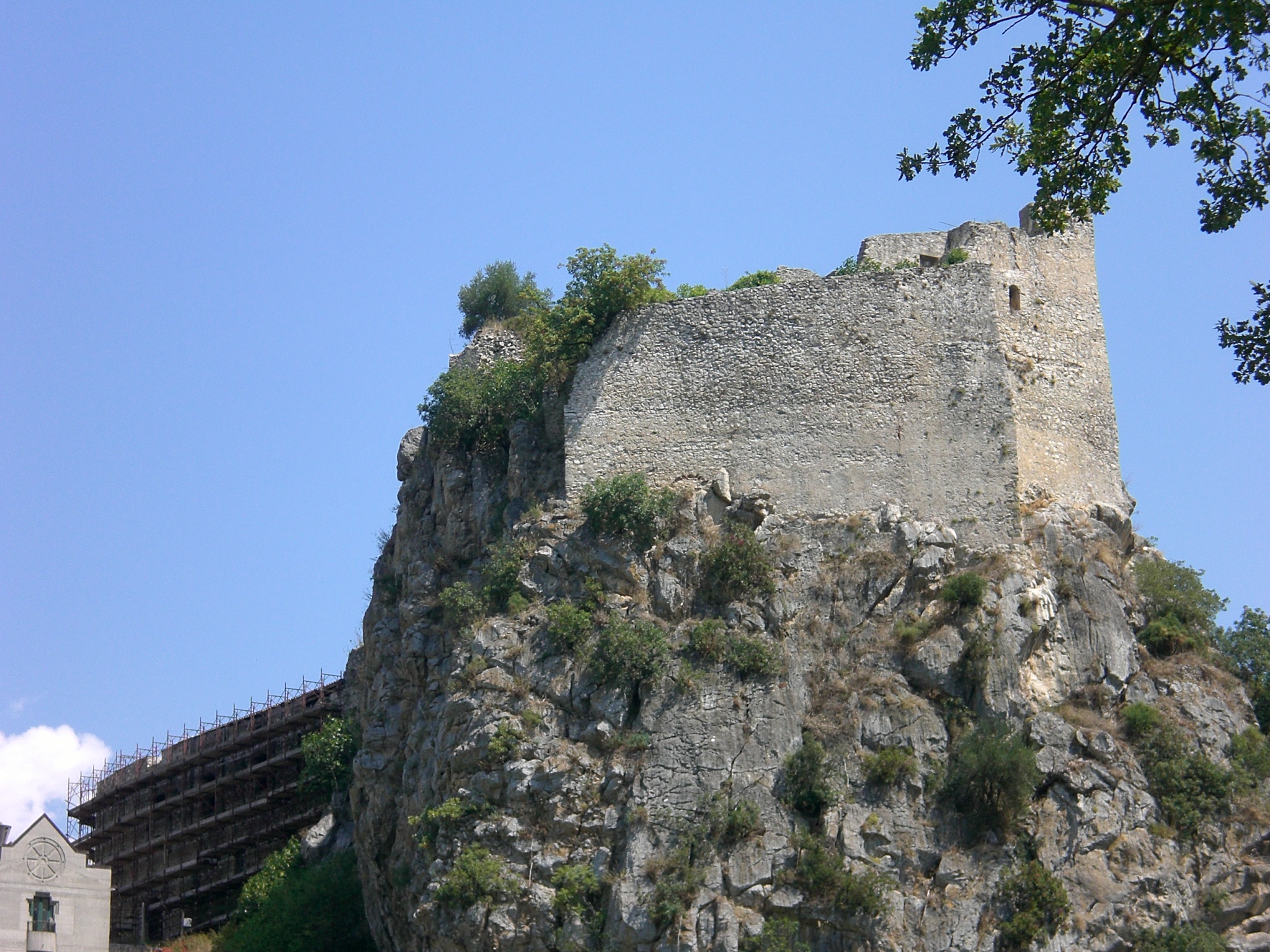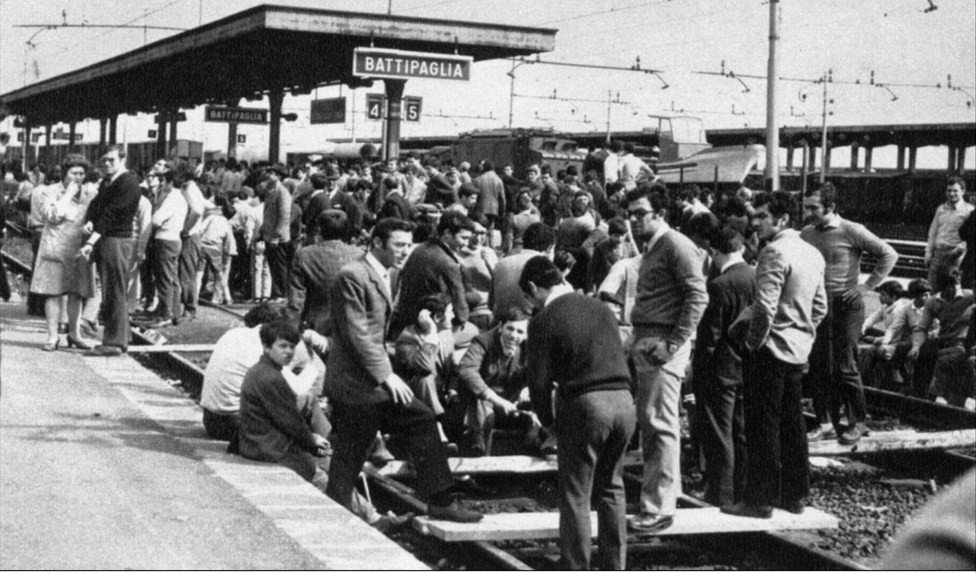|
Balvano Train Disaster
The Balvano train disaster was the deadliest railway accident in Italian history and one of the worst railway disasters ever. It occurred on the night between 2–3 March 1944 in Balvano, Basilicata. Over 500 people in a steam-hauled, coal-burning freight train (mostly stowaways) died of carbon monoxide poisoning during a protracted stall in a tunnel. Circumstances In 1943, Axis Italy was invaded by British and American armed forces, and the southern part of the peninsula (almost fully conquered by Allied forces) suffered severe wartime shortages, encouraging an extensive black market. People in large cities like Naples began bartering fresh produce for commodities brought by servicemen, and stowed away on freight trains to reach their suppliers' farms. The railway companies also suffered shortages of good-quality coal. The burning of low-grade substitutes developed a reduced power output and produced a large volume of carbon monoxide, an odorless and poisonous gas, a par ... [...More Info...] [...Related Items...] OR: [Wikipedia] [Google] [Baidu] |
Balvano
Balvano ( Lucano: ) is a small city and a ''commune'' in the province of Potenza (Basilicata, southern Italy). The recent history of Balvano is connected to several catastrophes. In 1944, a steam train stalled in a nearby railway tunnel, suffocating 426 passengers. It was also one of the towns nearly destroyed by the 1980 Irpinia earthquake The 1980 Irpinia earthquake ( it, Terremoto dell'Irpinia) took place in Italy on 23 November 1980, with a moment magnitude of 6.9 and a maximum Mercalli intensity of X (''Extreme''). It left at least 2,483 people dead, at least 7,700 injured, .... Cities and towns in Basilicata {{Basilicata-geo-stub ... [...More Info...] [...Related Items...] OR: [Wikipedia] [Google] [Baidu] |
Freighthopping
Freighthopping or trainhopping is the act of surreptitiously boarding and riding a freight railroad car, which is usually illegal. Origins and history In the United States, freighthopping became a common means of transportation following the American Civil War as the railroads began pushing westward, especially among migrant workers who became known as " hobos". It continued to be widely used by those unable to afford other transportation, especially during times of widespread economic dislocation such as the Great Depression. For a variety of reasons the practice is less common in the 21st century, although a community of freight-train riders still exists. The practice was heralded in popular culture of 20th century America with songs such as " King of the Road", and films like ''Emperor of the North Pole''. Typically, hoppers will go to a rail yard where the trains switch out crew. They will either know from other riders of a spot to hide and wait, or they will find on ... [...More Info...] [...Related Items...] OR: [Wikipedia] [Google] [Baidu] |
Sandbox (locomotive)
A sandbox is a container on most locomotives, multiple units and trams that holds sand, which is dropped on the rail in front of the driving wheels in wet and slippery conditions and on steep grades to improve traction. Sand delivery The sand may be delivered by gravity, by a steam-blast (steam locomotives) or by compressed air. Gravity sanding requires that the sand be dry so that it runs freely. Locomotives use multiple sandboxes, so that their delivery pipes could be short and nearly vertical. Engine sheds in the UK were equipped with sand drying stoves, so that sandboxes could be refilled each morning with dry sand. Steam locomotives in the US had a single sandbox, called a sand dome, atop the boiler where the rising heat helped to dry the sand. Even with this arrangement, sand pipes tended to clog, and by the 1880s, pneumatic sanding systems were being proposed. Steam sanding The development of steam sanding was influential on locomotive design. As the sand could then be ... [...More Info...] [...Related Items...] OR: [Wikipedia] [Google] [Baidu] |
Bella-Muro Railway Station
Bella-Muro is a railway station near Bella, Italy. The station opened on 6 November 1877 and is located on the Battipaglia–Metaponto railway. The train services are operated by Trenitalia Trenitalia is the primary train operator in Italy. A subsidiary of Ferrovie dello Stato Italiane, itself owned by the Italian government, the company was established in 2000 following a European Union directive on the deregulation of rail transp .... Train services The station is served by the following service(s): *Intercity services Rome - Naples - Salerno - Taranto *Regional services (''Treno regionale'') Naples - Salerno - Potenza - Metaponto - Taranto References ''This article is based upon a translation of the Italian language version as at June 2014.'' Railway stations in Basilicata Buildings and structures in the Province of Potenza Railway stations opened in 1877 1877 establishments in Italy Railway stations in Italy opened in the 1870s {{Italy-railstation-stub ... [...More Info...] [...Related Items...] OR: [Wikipedia] [Google] [Baidu] |
Eboli Railway Station
Eboli is a railway station in Eboli Eboli ( Ebolitano: ) is a town and ''comune'' of Campania, southern Italy, in the province of Salerno. An agricultural centre, Eboli is known mainly for olive oil and for its dairy products, among which the famous buffalo mozzarella from the a ..., Italy. The station is located on the Battipaglia–Metaponto railway. The train services are operated by Trenitalia. Train services The station is served by the following service(s): *Intercity services Rome - Naples - Salerno - Taranto *Regional services (''Treno regionale'') Naples - Salerno - Potenza - Metaponto - Taranto References ''This article is based upon a translation of the Italian language version as at June 2014.'' Railway stations in Campania Buildings and structures in the Province of Salerno {{Italy-railstation-stub Railway stations in Italy opened in 1863 ... [...More Info...] [...Related Items...] OR: [Wikipedia] [Google] [Baidu] |
KkStB Class 80
The Imperial-Royal State Railways (german: k.k. Staatsbahnen) abbr. ''kkStB'') or Imperial-Royal Austrian State Railways (''k.k. österreichische Staatsbahnen'',The name incorporating "Austrian" appears, for example, in the 1907 official state handbook (''Staatshandbuch'') and on the title page of the Imperial-Royal Railway Ministry publication''Die neuen österr(eichischen) Alpenbahnen'' Maass’ Söhne, Vienna, 1908.) was the state railway organisation in the Cisleithanian (Austrian) part of the Austro-Hungarian Monarchy. History The introduction of railway traffic in the Austrian Empire had been pushed by pioneers like physicist Franz Josef Gerstner (1756–1832), who advocated a railway connection from the Vltava basin across the Bohemian Massif to the Danube river. After in 1810 a first long horse-drawn railway line was built at the Eisenerz mine in Styria for the transport of iron stones, in 1832 a wagonway between Austrian Linz and České Budějovice (Budweis) in Bohem ... [...More Info...] [...Related Items...] OR: [Wikipedia] [Google] [Baidu] |
FS Class 480
The Ferrovie dello Stato (FS; Italian State Railways) Class 480 (Italian: ''Gruppo 480'') is a 2-10-0 steam locomotive. Design and construction The Class 480 was expressly designed for the Brenner Railway, after the First World War had resulted in Italy and the FS taking possession of it up to its summit at the Brenner Pass. Previously the Austrian company Südbahn had worked the line with its powerful 2-10-0 SB 580 locomotives, ten of which had remained south of the new border and had been taken over by the FS as Class 482; these were however insufficient, and the Italian Class 470 locomotive, while powerful, did not have enough steaming to adequately last for the section from Bolzano to the summit. Therefore, it was decided to design a new locomotive based on the Class 482. The Class 480 was fitted with an Italian bogie, the central driving wheels had their flanges reduced, and the last driving axle was given some lateral play to allow the locomotive to deal with sharp ... [...More Info...] [...Related Items...] OR: [Wikipedia] [Google] [Baidu] |
Battipaglia
Battipaglia () is a municipality ('' comune'') in the province of Salerno, Campania, south-western Italy. Famed as a production place of buffalo mozzarella, Battipaglia is the economic hub of the Sele plain. History Formerly part of the ancient Greek colonies of the Magna Graecia, the municipal area used to host strategic Roman settlements during the late Republican- early Imperial times, like most of the southern Tyrrhenian coast. Archaeological excavations have brought to light several finds dating back to as early as the 3rd century BC pertaining to at least two villas. One of those was located in the vicinity of the coastline and was part of a larger thermal complex. The other was positioned internally and likely served as a productive belt between cereal crops in the plain and olive crops and vineyards on the hill. The town was first given its modern name in 1080 within a bureaucratic document of the Duchy of Apulia and Calabria addressed to the local Catholic dioc ... [...More Info...] [...Related Items...] OR: [Wikipedia] [Google] [Baidu] |
FS Class E
FS, fS or fs may refer to: Arts and entertainment * FS (musician) (real name Fred Sargolini), American dubstep producer and DJ from New York * FS Catalogue, a numbered list of all compositions by Carl Nielsen * FS Film, a Finnish film distributor * Flight simulator, a professional simulator of planes ** Amateur flight simulation, a video game version of simulators ***'' Microsoft Flight Simulator'', an amateur flight simulator series ****''Microsoft Flight Simulator X'', the 2006 edition, commonly referred to as ''FSX'' **** ''Microsoft Flight Simulator'' (2020 video game), the 2020 edition, commonly referred to as ''FS'' Businesses and organizations In transportation * ''Ferrocarril de Sóller'', a railway on Majorca * ''Ferrovie dello Stato'', Italian state railways * First ScotRail, a British rail train operator * ItAli Airlines (IATA airline designator FS) * FS Trenitalia Italian railway company Other businesses and organizations * Frankfurt School of Finance & Manageme ... [...More Info...] [...Related Items...] OR: [Wikipedia] [Google] [Baidu] |
Potenza
Potenza (, also , ; , Potentino dialect: ''Putenz'') is a ''comune'' in the Southern Italian region of Basilicata (former Lucania). Capital of the Province of Potenza and the Basilicata region, the city is the highest regional capital and one of the highest provincial capitals in Italy, overlooking the valley of the Basento river in the Apennine Mountains of Lucania, east of Salerno. Its territory is bounded by the comuni of Anzi, Avigliano, Brindisi Montagna, Picerno, Pietragalla, Pignola, Ruoti, Tito and Vaglio Basilicata. History of Potenza Ancient times The first settlement of Potentia (Potenza's original Latin name) was probably located at a lower elevation than at present, some south of today's Potenza. The Lucanians of Potentia sided against Rome's enemies during the latter's wars against the Samnites and the Bruttii. Subjugated during the 4th century BC (later gaining the status of ''municipium''), the Potentini rebelled after the Roman defeat at Cannae ... [...More Info...] [...Related Items...] OR: [Wikipedia] [Google] [Baidu] |
.jpg)


.jpg)

